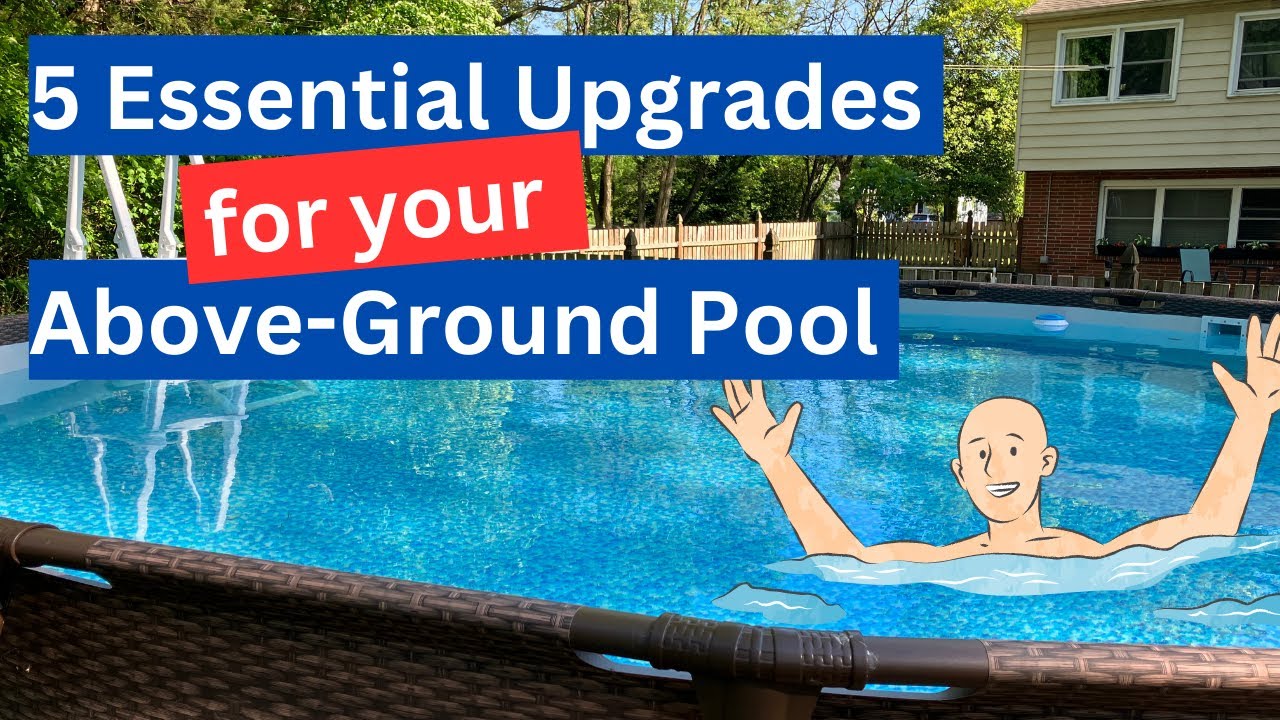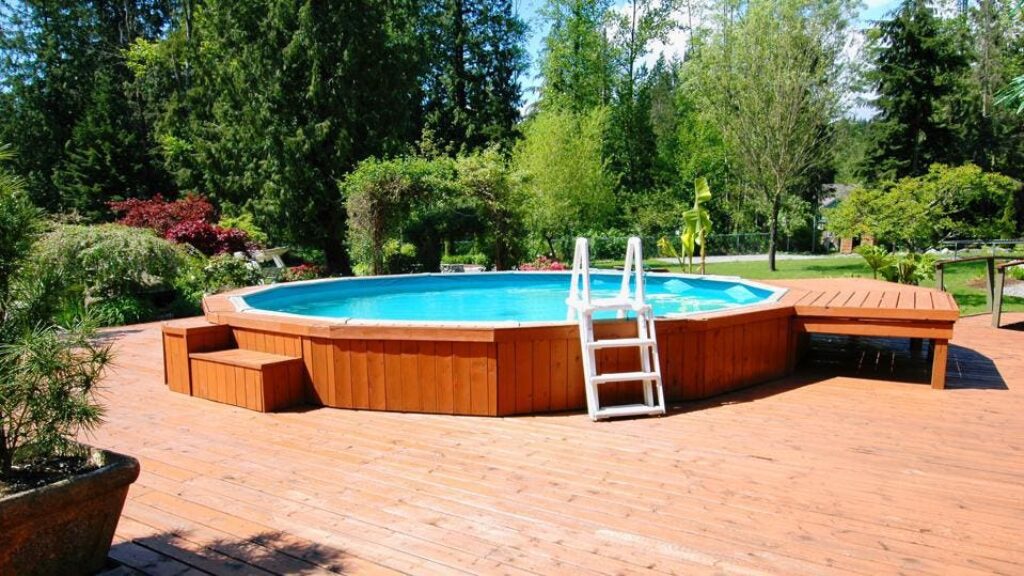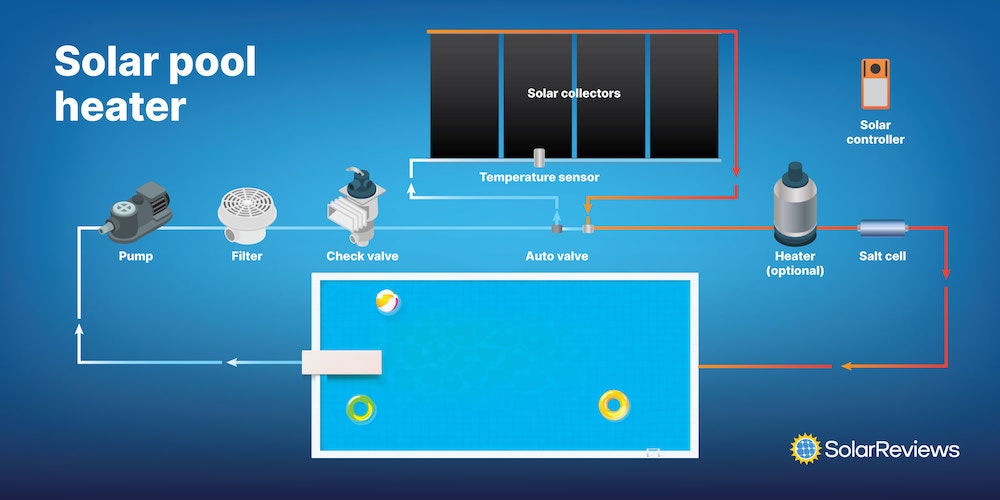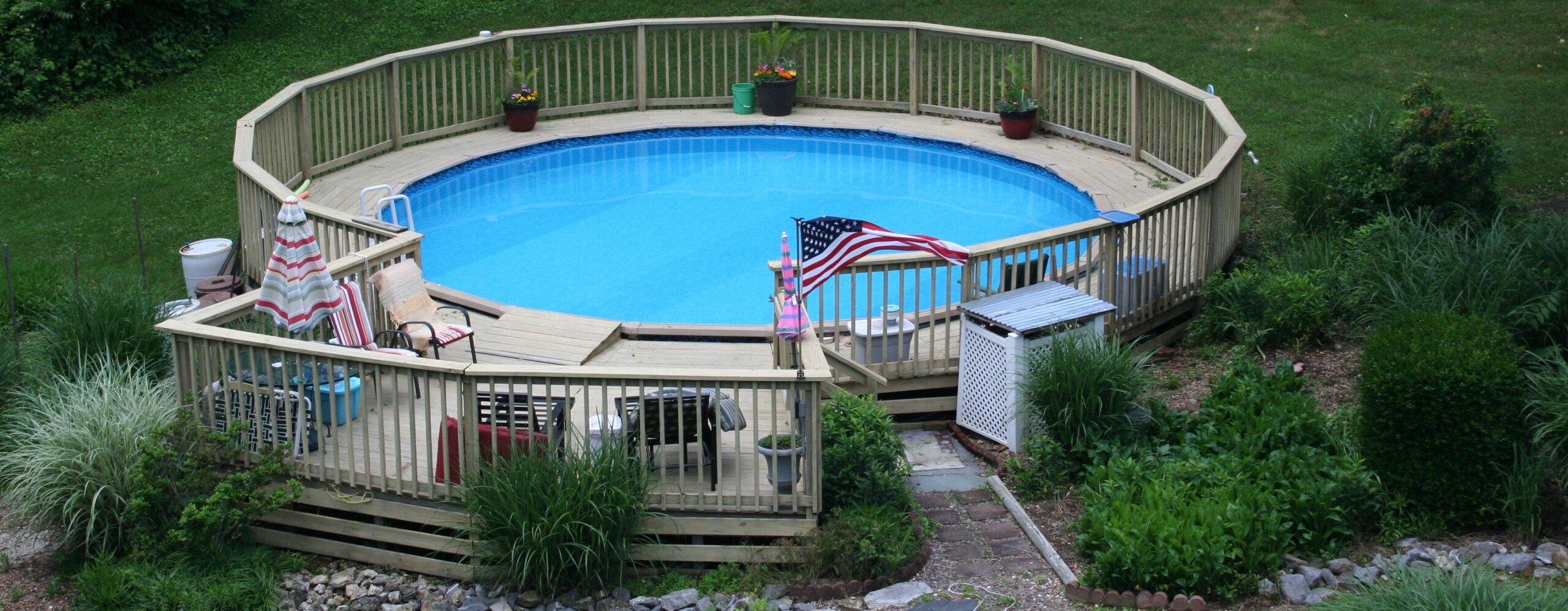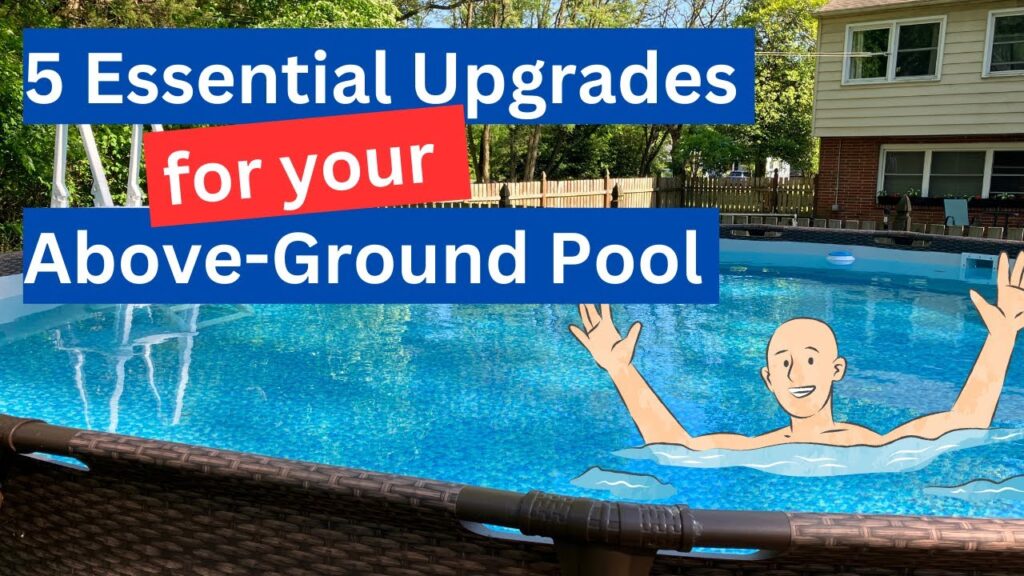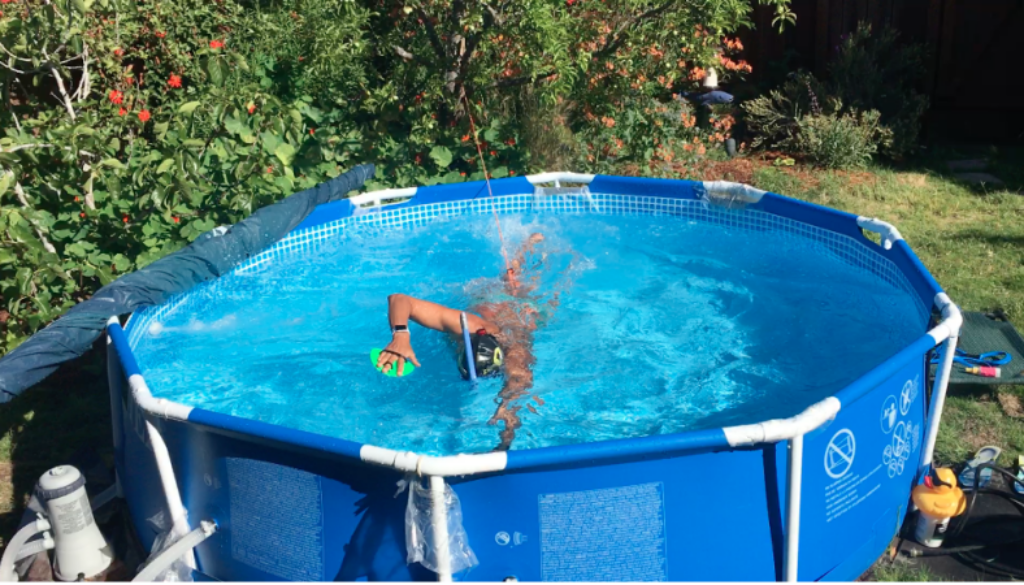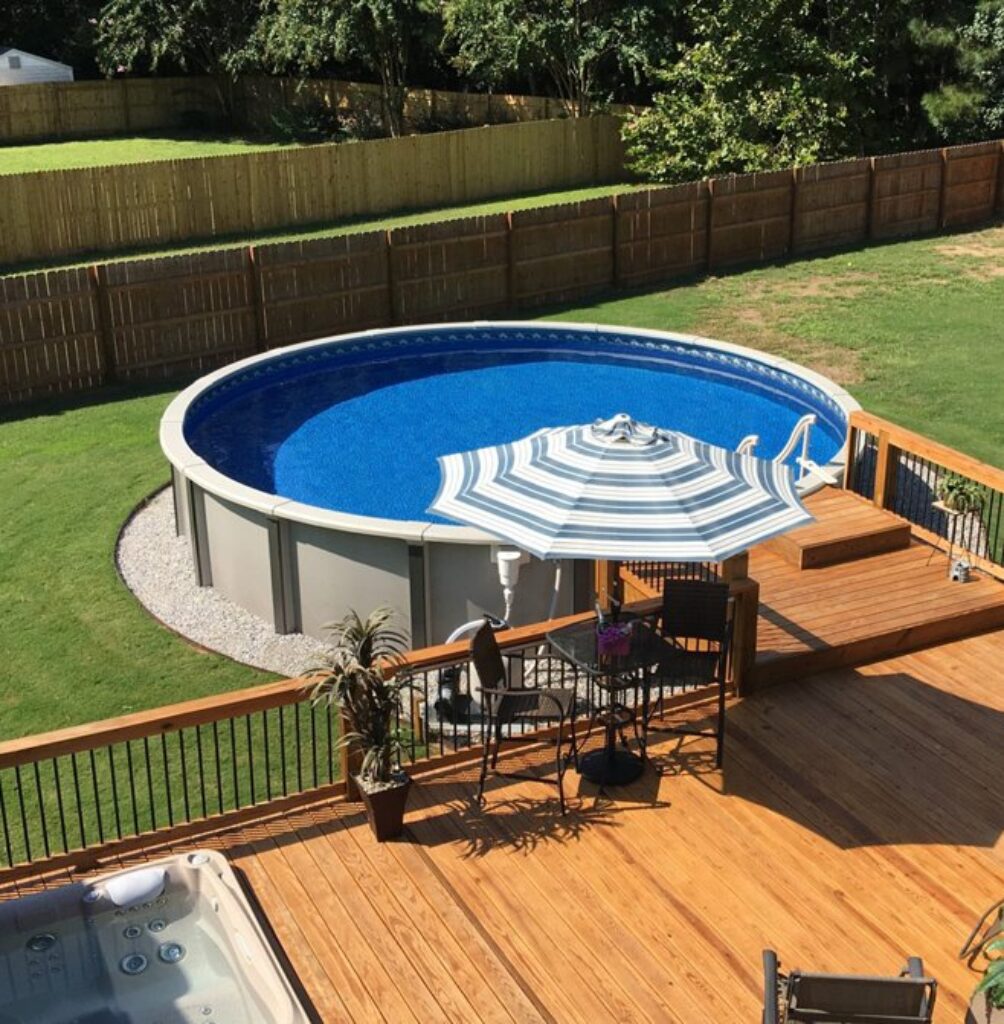Are you ready to transform your above ground pool into a backyard oasis? In this article, we will delve into the world of DIY pool upgrades, guiding you on how to take your pool to the next level. From simple additions like pool lights and solar covers to more advanced upgrades such as decking and landscaping, we will explore various options that will not only enhance the aesthetic appeal but also improve the functionality of your pool. Get ready to turn your ordinary pool into a stunning and inviting space where you can relax, entertain, and create lasting memories.
This image is property of thumbor.forbes.com.
1. Types of Above Ground Pools
1.1. Inflatable Pools
Inflatable pools are a popular choice for those looking for a temporary, easy-to-set-up option. These pools are typically made of durable materials such as PVC or vinyl and can be inflated using an air pump. Inflatable pools are great for small spaces and can be quickly assembled and disassembled. However, they may not offer the same level of durability and stability as other types of above ground pools.
1.2. Steel Frame Pools
Steel frame pools are known for their sturdiness and durability. These pools have a frame made of galvanized steel, which provides excellent support and stability. Steel frame pools are available in various shapes and sizes, making them suitable for different backyard layouts. These pools often come with a vinyl liner, which adds an extra layer of protection and enhances the pool’s overall aesthetic.
1.3. Resin Frame Pools
Resin frame pools are gaining popularity due to their resistance to corrosion and their ability to withstand harsh weather conditions. These pools have frames made of resin, a type of durable plastic material. Resin frame pools are known for their longevity, and they often come with features like built-in seats or safety ladders. These pools require minimal maintenance and are a great option for those looking for a long-lasting above ground pool.
2. Benefits of Upgrading Your Above Ground Pool
2.1. Improved Aesthetics
One of the significant benefits of upgrading your above ground pool is the improved aesthetics it brings to your backyard. Newer pool liners, stylish deck materials, and modern pool lighting can transform the look and feel of your pool area. Upgrading your pool allows you to choose designs and materials that complement your outdoor space, creating a more visually appealing and inviting atmosphere for you and your guests.
2.2. Increased Durability
Another advantage of upgrading your above ground pool is increased durability. Older pools may be more susceptible to wear and tear, potentially leading to leaks, rust, and other issues. By upgrading your pool with more robust materials, such as a steel frame or a high-quality pool liner, you can ensure that your pool will last for years to come. This increased durability provides peace of mind and minimizes the need for costly repairs or replacements down the line.
2.3. Enhanced Safety Features
Upgrading your above ground pool can also improve the safety features of your pool area. Installing a pool cover, for example, can help prevent accidents and keep children or pets from entering the pool unsupervised. Adding built-in safety ladders or handrails to your pool deck can also provide additional stability and support when entering or exiting the pool. These safety upgrades can give you greater confidence in enjoying your pool and minimize potential risks.
2.4. Added Functionality and Convenience
When you upgrade your above ground pool, you have the opportunity to add new features and enhance its functionality. Upgrading the pool filter, for example, can improve water circulation and maintain cleaner, clearer water. Adding a pool heating system allows you to extend your swimming season, enjoying your pool even during cooler months. By enhancing the convenience and functionality of your pool, you can maximize your enjoyment and make the most of your investment.
3. Pre-Upgrade Considerations
3.1. Assessing Your Current Pool
Before embarking on any pool upgrade project, it’s essential to assess the current condition of your pool. Take note of any leaks, cracks, or signs of wear and tear that may indicate the need for specific repairs or replacements. Consider the size and shape of your pool area, as well as any existing features or limitations that may impact your upgrade options. By understanding your pool’s current state, you can make more informed decisions when choosing the right upgrades for your needs.
3.2. Setting a Budget
Setting a budget is a crucial step in planning your pool upgrades. Determine how much you are willing to spend on materials, tools, and any professional assistance you may require. Research the cost of the specific upgrades you’re considering, taking into account any additional expenses like permits or installation fees. By having a clear budget in mind, you can prioritize your upgrades and make informed choices that align with your financial goals.
3.3. Obtaining the Necessary Permits
Depending on the scope of your pool upgrades, you may need to obtain permits from your local authorities. Some upgrades that involve electrical or plumbing work may require permits to ensure compliance with local building codes and safety regulations. Contact your local municipality or building department to inquire about the necessary permits for your upgrades. Taking the time to secure the appropriate permits will help ensure that your upgrades are done correctly and prevent any potential legal issues in the future.
3.4. Researching Local Building Codes
Familiarize yourself with the building codes and regulations specific to your area before starting your pool upgrades. Different regions may have different requirements for pool safety, fencing, setback distances, and other factors that may impact your upgrade plans. By understanding and complying with the local building codes, you can prevent delays, penalties, and the need for costly modifications later on.
4. DIY Pool Upgrade Ideas
4.1. Installing a Pool Liner
One of the most impactful upgrades you can make to your above ground pool is installing a new pool liner. A pool liner not only enhances the aesthetics of your pool but also acts as a protective barrier between the water and the pool structure. Choose a liner that suits your style and preferences, and ensure it is compatible with your pool’s dimensions and shape. A pool liner installation kit, including the liner, coping strips, and adhesive, will be necessary for a successful installation.
4.2. Upgrading the Pool Filter
Upgrading your pool filter can significantly improve the water quality and overall cleanliness of your pool. Consider upgrading to a more efficient and effective filter system, such as a sand filter or a cartridge filter. These upgraded filter systems can remove finer particles and contaminants from the water, resulting in clearer and healthier pool water. A pool filter upgrade kit, including the new filter and any necessary plumbing connectors, will be needed for the installation.
4.3. Adding Pool Lighting
Adding pool lighting can create a stunning visual effect and enhance the nighttime ambiance of your pool area. LED lights are a popular choice due to their energy efficiency and versatility. Consider installing underwater lights to illuminate the pool or perimeter lights to highlight the surrounding landscape. A pool lighting kit, including the lights, transformers, and wiring, will be required for the installation.
4.4. Building a Pool Deck
A pool deck not only provides a safe and convenient area for lounging and sunbathing but also adds a touch of sophistication and functionality to your pool. When building a pool deck, choose materials that are durable, slip-resistant, and resistant to moisture and UV rays. Deck building materials such as composite decking or pressure-treated lumber are excellent options for their longevity and low-maintenance qualities.
4.5. Installing a Pool Heater
Extend your swimming season by installing a pool heater. A pool heater allows you to enjoy your pool even when the weather gets cooler by maintaining a comfortable water temperature. Choose a pool heater that suits your pool size and climate. Options include gas heaters, heat pumps, and solar heaters. A pool heater kit, including the heater unit, plumbing connectors, and any necessary electrical components, will be necessary for installation.
4.6. Enhancing Water Circulation
Efficient water circulation is essential for maintaining clean and healthy pool water. Consider upgrading your pool’s water circulation system by adding features such as additional pool returns, water jets, or a variable-speed pump. These upgrades can improve water movement, preventing stagnation, and enhancing filtration. Water circulation system components, such as additional return fittings or a variable-speed pump, will be needed for the upgrade.
4.7. Adding a Pool Cover
Installing a pool cover is a practical and cost-effective upgrade that can help keep your pool clean, reduce evaporation, and enhance safety. Choose a pool cover that suits your needs, whether it’s a manual cover, an automatic cover, or a solar cover. A pool cover kit, including the cover itself and any necessary installation hardware, will be required for this upgrade.
4.8. Constructing a Pool Slide
If you have children or enjoy entertaining guests, adding a pool slide can be a fun and exciting upgrade to your pool area. Pool slides come in various sizes and styles, including straight slides, curved slides, and even slides with built-in water sprayers. Ensure the pool slide is compatible with the dimensions and structure of your pool. Pool slide construction materials, including the slide structure, ladder, and slide surface, will be needed for this upgrade.
4.9. Incorporating a Water Feature
Incorporating a water feature, such as a waterfall, fountain, or bubbling jets, can add a touch of luxury and tranquility to your pool area. Water features create a soothing and visually pleasing atmosphere, enhancing your pool experience. Determine the type and style of water feature that suits your preferences and backyard aesthetics. Water feature components, including the pump, plumbing connectors, and any decorative elements, will be required for the installation.
4.10. Implementing a Saltwater System
Consider upgrading your pool to a saltwater system for a more natural and low-maintenance swimming experience. Saltwater pools use salt chlorinators to convert salt into chlorine, eliminating the need for traditional chlorine chemical additives. This upgrade can result in softer, more enjoyable pool water while reducing the need for manual chlorine dosing. A saltwater system conversion kit, including the salt chlorinator and necessary plumbing components, will be required for this upgrade.
This image is property of i.ytimg.com.
5. Tools and Materials Needed
5.1. Pool Liner Installation Kit
- Pool liner
- Coping strips
- Adhesive
- Utility knife
- Tape measure
- Shop vacuum
5.2. Pool Filter Upgrade Kit
- Pool filter
- Plumbing connectors
- Lubricating grease
- Screwdriver or wrench
- Teflon tape
5.3. Pool Lighting Kit
- LED pool lights
- Transformers
- Wiring
- Drill or hole saw
- Electrical connectors
- Waterproof sealant
5.4. Deck Building Materials
- Composite decking boards or pressure-treated lumber
- Deck screws or nails
- Post anchors or deck blocks
- Circular saw or miter saw
- Power drill
- Level
5.5. Pool Heater Kit
- Pool heater unit
- Plumbing connectors
- Electrical components (if applicable)
- Gas line (for gas heaters)
- Screwdriver or wrench
- Teflon tape
5.6. Water Circulation System Components
- Additional pool returns or water jets
- Variable-speed pump
- PVC piping and connectors
- Pool adhesive or PVC cement
- Hacksaw or PVC pipe cutter
- Screwdriver
- Level
5.7. Pool Cover Materials
- Pool cover
- Installation hardware (anchors, straps, etc.)
- Drill or screwdriver
- Measuring tape
- Level
5.8. Pool Slide Construction Materials
- Pool slide
- Slide ladder
- Slide surface materials (acrylic, fiberglass, etc.)
- Drill or screwdriver
- Measuring tape
- Level
5.9. Water Feature Components
- Water feature pump
- Plumbing connectors
- Decorative elements (rock formations, water sprayers, etc.)
- Electrical components (if applicable)
- Teflon tape
- Drill or hole saw
5.10. Saltwater System Conversion Kit
- Salt chlorinator
- Plumbing connectors
- Pool salt
- Test strips or kit
- Water balancers (if necessary)
- Screwdriver or wrench
- Teflon tape
6. Step-by-Step Guide to DIY Pool Upgrades
6.1. Preparing the Pool for Upgrades
- Drain the pool water to an appropriate level.
- Clean the pool thoroughly, removing any debris or algae.
- Inspect the pool structure for any signs of damage or deterioration.
- Make any necessary repairs before proceeding with the upgrades.
6.2. Removing the Old Pool Liner
- Start by removing the pool’s top rail or coping.
- Remove the old pool liner, starting from one side and gradually working your way around.
- Use a utility knife to cut the liner into manageable sections for easier removal.
- Use a shop vacuum to remove any remaining water or debris from the pool.
6.3. Installing the New Pool Liner
- Measure the pool dimensions and select a new pool liner that matches the size and shape.
- Lay out the new pool liner and allow it to acclimate to the temperature and humidity of the pool area.
- Install the coping strips along the top edge of the pool, ensuring they are evenly spaced and secure.
- Begin installing the new pool liner by aligning one side with the pool wall and the coping strips.
- Slowly work your way around the pool, attaching the liner to the coping strips and smoothing out any wrinkles or creases.
- Use adhesive as necessary to secure the liner in place.
- Once the liner is properly installed, fill the pool with water, taking care to balance the water chemistry.
6.4. Upgrading the Pool Filter
- Turn off the pool’s filtration system and disconnect the power supply.
- Remove the existing pool filter, following the manufacturer’s instructions.
- Install the new pool filter, ensuring it is compatible with the existing plumbing connections.
- Use plumbing connectors, lubricating grease, and Teflon tape as necessary to secure the filter in place and prevent leaks.
- Turn on the filtration system and check for proper operation.
- Prime the new filter according to the manufacturer’s instructions.
6.5. Installing Pool Lighting
- Determine the desired location and number of pool lights.
- Drill or use a hole saw to create openings in the pool wall for the lights.
- Install the lights into the openings and secure them in place.
- Connect the wiring, transformers, and any necessary electrical components.
- Seal the openings and connections with waterproof sealant to prevent water infiltration.
- Test the lights to ensure they are functioning correctly.
6.6. Building a Pool Deck
- Plan the layout and design of your pool deck, considering factors such as size, shape, and materials.
- Prepare the ground by removing any grass, weeds, or debris in the deck area.
- Install post anchors or deck blocks as necessary to support the deck structure.
- Construct the deck frame using the chosen materials, following the design and layout plan.
- Install the deck boards onto the frame, securing them with screws or nails.
- Make any necessary adjustments to ensure the deck is level and sturdy.
- Finish the deck by sanding, staining, or painting the deck surface as desired.
6.7. Installing a Pool Heater
- Determine the appropriate location for the pool heater, considering factors such as space, ventilation, and accessibility to gas or electrical connections.
- Install the pool heater unit, ensuring it is securely mounted and level.
- Connect the plumbing connectors, ensuring proper alignment and tight connections.
- Install any necessary electrical components, following the manufacturer’s instructions.
- If using a gas heater, connect the gas line and ensure a proper seal using Teflon tape.
- Test the heater to ensure it is functioning correctly and heating the pool water to the desired temperature.
6.8. Enhancing Water Circulation
- Determine the desired location for additional pool returns or water jets.
- Install the additional pool returns or water jets, ensuring they are securely mounted and aligned properly.
- Connect the PVC piping and connectors, using pool adhesive or PVC cement for a tight and leak-free connection.
- Test the water circulation system to ensure proper water movement and filtration.
6.9. Adding a Pool Cover
- Determine the type of pool cover that suits your needs, whether it’s a manual cover, an automatic cover, or a solar cover.
- Install the pool cover according to the manufacturer’s instructions, ensuring it is securely anchored or fastened.
- Test the pool cover to ensure it operates smoothly and provides the desired coverage.
6.10. Constructing a Pool Slide
- Determine the desired location and size for the pool slide, considering factors such as safety, slide path, and available space.
- Install the slide ladder, ensuring it is securely anchored and level.
- Construct the slide structure and attach the slide surface materials, following the manufacturer’s instructions.
- Test the slide to ensure it is stable and safe for use.
6.11. Incorporating a Water Feature
- Choose the desired water feature type and style, considering factors such as size, flow rate, and compatibility with your pool.
- Install the water feature pump, ensuring it is securely mounted and level.
- Connect the plumbing connectors, following the manufacturer’s instructions for proper alignment and connection.
- Install any decorative elements, such as rock formations or water sprayers, to enhance the water feature’s aesthetics.
- Test the water feature to ensure proper operation and water flow.
6.12. Implementing a Saltwater System
- Determine the appropriate location for the salt chlorinator unit, considering factors such as space, accessibility, and plumbing connections.
- Install the salt chlorinator unit, following the manufacturer’s instructions for proper mounting and connection.
- Connect the plumbing connectors, ensuring a secure and leak-free connection.
- Add the appropriate amount of pool salt to the water, according to the manufacturer’s recommendations.
- Test the water using test strips or a test kit, and adjust the water balancers as necessary to achieve the recommended salt level and water chemistry.
This image is property of i0.wp.com.
7. Maintenance and Care for Upgraded Pools
7.1. Regular Cleaning and Debris Removal
Maintaining a clean pool is essential for the longevity and enjoyment of your upgraded pool. Regularly skim the surface of the water to remove leaves, debris, and insects. Use a pool brush and vacuum to clean the pool walls and floor. Empty and clean the skimmer and pump baskets regularly to maintain optimal water flow.
7.2. Proper Chemical Balance
Regularly test the pool water and adjust the chemical levels as necessary to ensure proper water balance. Maintain appropriate levels of chlorine, pH, alkalinity, and calcium hardness to prevent issues such as algae growth, cloudy water, or equipment damage. Follow the manufacturer’s guidelines and use pool chemicals safely and correctly.
7.3. Inspecting and Repairing Pool Equipment
Regularly inspect the pool equipment, including the filter, pump, heater, and any other upgraded components. Look for signs of leaks, loose connections, or worn parts. Replace any damaged or faulty components promptly to prevent further damage or potential safety hazards.
7.4. Winterizing the Pool
If you live in a climate with freezing temperatures, it is essential to properly winterize your pool to protect it from potential damage. Lower the water level, clean and balance the water chemistry, and drain and store any upgraded components that are susceptible to freezing. Cover the pool with an appropriate winter cover, ensuring it is securely fastened to prevent debris accumulation.
8. Hiring Professional Help for Complex Upgrades
8.1. When to Consider Professional Assistance
While many above ground pool upgrades can be done as DIY projects, certain complex upgrades may require professional assistance. If you are not comfortable with electrical or plumbing work, or if the upgrade involves major structural modifications, it is best to consult with a professional pool contractor. Additionally, if you are unsure about local building codes, permits, or safety requirements, seeking professional guidance can ensure compliance and prevent potential issues.
8.2. Choosing a Reliable Pool Contractor
When hiring a pool contractor for your upgrades, it is important to choose a reliable and experienced professional. Research reputable contractors in your area and check their credentials, certifications, and customer reviews. Request quotes from multiple contractors and compare their services, pricing, and warranties. Choose a contractor who can provide references and a clear timeline for the project.
8.3. Obtaining Quotes and Comparing Costs
When obtaining quotes from pool contractors, be sure to provide detailed information about the upgrades you require. Ask for a breakdown of costs, including labor, materials, and permits. Compare quotes from different contractors and consider factors such as reputation, experience, and projected timeline. While cost is an important consideration, be wary of excessively low bids or hidden fees that may indicate subpar workmanship.
This image is property of www.risingsunpools.com.
9. Conclusion
9.1. Recap of DIY Pool Upgrades
In this comprehensive guide, we have explored various DIY pool upgrades to take your above ground pool to the next level. From installing a new pool liner and upgrading the pool filter to building a pool deck and incorporating water features, there are numerous ways to enhance the aesthetics, functionality, and safety of your pool area. We have also provided a step-by-step guide, tools and materials, and tips for maintenance and care to help you successfully complete your pool upgrades.
9.2. Enjoying Your Upgraded Above Ground Pool
By upgrading your above ground pool, you can create a more inviting and enjoyable backyard oasis for yourself, your family, and your friends. Whether you choose to tackle the upgrades as DIY projects or enlist the help of a professional, the end result will be a pool that reflects your personal style and enhances your swimming experience. So dive in, relax, and enjoy the benefits of your upgraded above ground pool!
